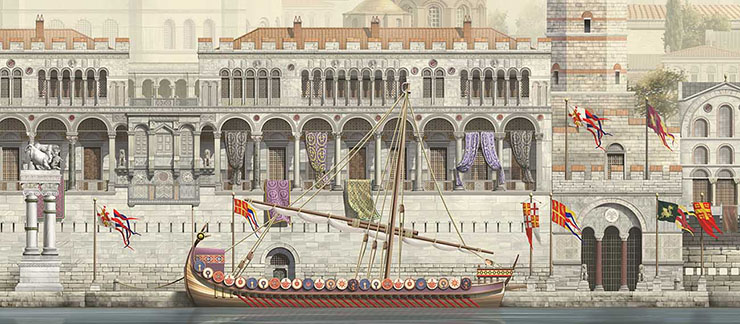 Over the last 30 years one of the saddest areas in Istanbul was the neglected ruins of an Imperial palace that was built into the seawall. I first saw it in 1972, on my first trip to Constantinople-Istanbul. I will never forget my ride into the city from the airport and my first sight of the great Land Walls and Hagia Sophia. I was here after so many years of dreaming of it. As I was on my way I looked for all the landmarks I had studied since I was a kid. I knew the places where the vanished churches had been, like the Theotokos Peribleptos. and just being were they had been was exhilarating and made me strangely happy despite of desolation of ancient Constantinople in front of me at last. of course the goal of this pilgrimage was Hagia Sophia - which I did not see that first day. We turned for the Pera Bridge as it got dark... I saw the Pantokrator on the hill on the left as we passed through the Aqueduct of Valens. On the side of the hill you could see the remains of the walls of an ancient cistern attached to the Pantokrator monastery. When I got into my hotel room at the Hilton on Taksim Square I had a view over the city and could see everything, even in the darkness. The minarets were lit all over the city. What a feeling of anticipation. I couldn't sleep and watched the sun rise over the city. I had arranged for someone to drive me for two weeks.
Over the last 30 years one of the saddest areas in Istanbul was the neglected ruins of an Imperial palace that was built into the seawall. I first saw it in 1972, on my first trip to Constantinople-Istanbul. I will never forget my ride into the city from the airport and my first sight of the great Land Walls and Hagia Sophia. I was here after so many years of dreaming of it. As I was on my way I looked for all the landmarks I had studied since I was a kid. I knew the places where the vanished churches had been, like the Theotokos Peribleptos. and just being were they had been was exhilarating and made me strangely happy despite of desolation of ancient Constantinople in front of me at last. of course the goal of this pilgrimage was Hagia Sophia - which I did not see that first day. We turned for the Pera Bridge as it got dark... I saw the Pantokrator on the hill on the left as we passed through the Aqueduct of Valens. On the side of the hill you could see the remains of the walls of an ancient cistern attached to the Pantokrator monastery. When I got into my hotel room at the Hilton on Taksim Square I had a view over the city and could see everything, even in the darkness. The minarets were lit all over the city. What a feeling of anticipation. I couldn't sleep and watched the sun rise over the city. I had arranged for someone to drive me for two weeks.
On the left is a lion from th.JPG) e facade of the Boukoleon Palace. You can see a photograph below from 1860 with this lion still embedded in the facade of the palace.
e facade of the Boukoleon Palace. You can see a photograph below from 1860 with this lion still embedded in the facade of the palace.
During my two weeks I had a long list of things that I wanted to see and reviewed them with Ali. After we had been to a few places -like the site of the Blachernae palace he asked me why I wasn't interested in Ottoman things. He didn't It's true that you when we went to these locations there appeared to be nothing left of these famous Byzantine monuments. Except for Hagia Sophia, the Hippodrome and the Land Walls my driver knew nothing about the Byzantine history of the city of Istanbul. He would not rest until I had agreed to give him a day to show me mosques and ottoman palaces. I was interested in Sinan and had a pretty good knowledge of Ottoman history - which surprised him. I knew all of the Sultans and the historical events of their reigns. I knew all the palaces from books. I think he was gratified that I cared about Turkish history, too. However he noticed when I entered famous mosques I only seemed interested in speculating on which Byzantine monuments the columns in their atriums were taken from. This continued when we went to Topkapi Palace. That palace is chock full of Byzantine columns, marbles and even the remnants of altar screens from Byzantine churches. I am still astonished that no one has ever done a study of where all these things came from. I'll bet much of St. George of the Mangana can now be found there. It's obvious all of the columns and revetment that could be rooted out of the Great Palace and the altar screen of Hagia Sophia is most likely here as well. All of the precious marbles, the columns and such of Byzantium are still in Istanbul in later use.
One day Ali insisted I allow him to have a day where he had compete control of our itinerary. That day he told me now I would see the truly great wonders associated with the the Conquest and his great hero, Mehmet II. We went back and forth along the walls where he reenacted the great battles that took place here as the Turkish armies broke into the city. Then we had to follow the exact path where the Turkish armies took to Hagia Sophia were they liberated the church from the Christians. The last stop of the Mosque of the Conqueror and his tomb. Ali saw him as a hero and was proud of what he had done. I don't know why, but I felt like Ali did all of this to let me know "you will never get this place back". Since I'm not Greek I assume that would mean the Christians.
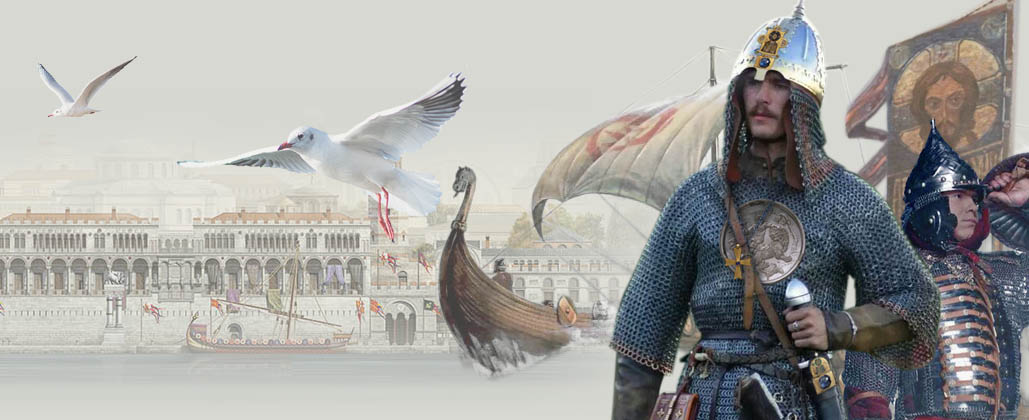
This was my first encounter with Turkish nationalism and this Turkish nationalism and the managed to destroy most of what remained of the Byzantine past. I told my driver Ali about this palace and he said he had never heard of it or new how to find it. I had pictures and a map. Eventually - after much driving around that area of the Great Palace - we were in front of it on the seashore. My driver was really amazed to see it and was truly amazed. He became very interested in it and wanted to know more. He was astounded to hear how old it was. We got back in his car up and down alleys we found a away to get into the palace from the back on the second floor. We were inside the actual vaulted rooms of it. The inside was overgrown and open to the elements. There was a thicket of plants and grasses there and even small trees. In places the floor opened up to other rooms in the substructure. Everywhere were fragments of marble sculpture, marble architectural elements, pieces of colored marble revetment a, Byzantine ceramic tiles and even pieces of mosaic. Huge chunks of vault set with mosaic had recently fallen to the ground. Ali said to me "If all of this is just lying here what treasure there must be underneath. Some of the pieces of revetment where large and you could easily tell what kinds marbles they were. There were broken up string courses of white marble that had once bordered these marble panels. In the mosaics that had fallen from the vaults you could see the ornamental floral motifs and gold. Just outside of these rooms you could see where the railway line, built in 1873 - had cut right through the ruins and obliterated a large part of it. Every person who traveled the Orient Express to Istanbul - tens of thousands of passengers - passed through this ruin without knowing what it was.
The picture below was taken by someone who got into the substructure like I did - he was there in 2015 - just three years ago. Click on the picture and you can read his report. I thought it was interesting that he said you can't find the Boukoleon on Google Earth. Maybe that's changed. The substructures are vast. The brickwork is really nice.
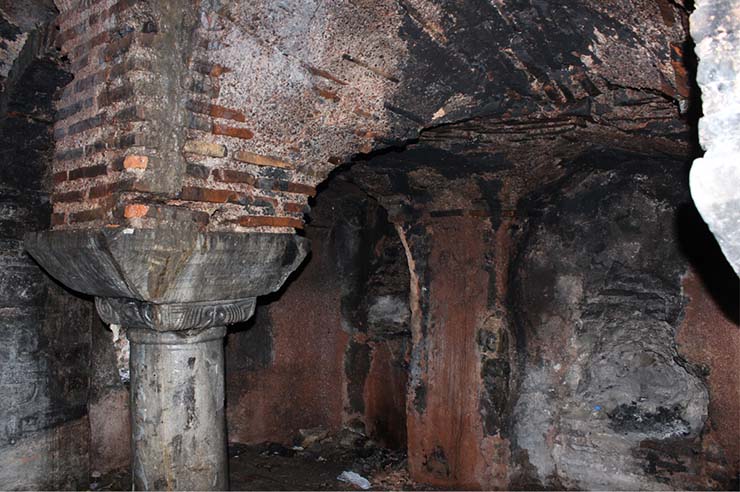
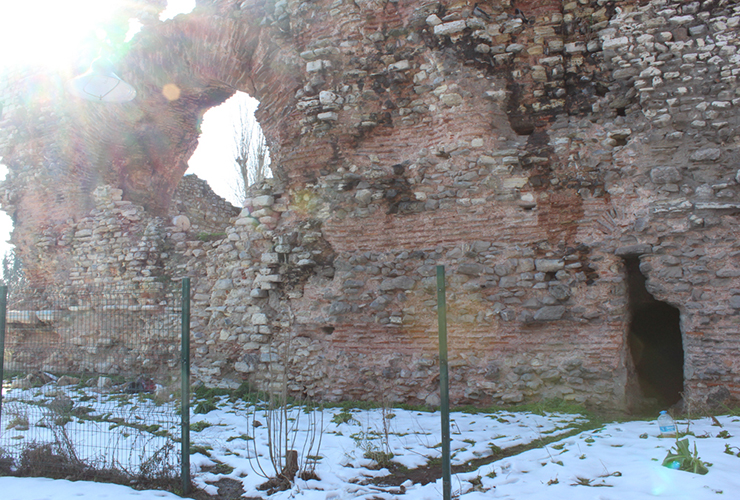 150 years ago a good part of the facade, it's splendid marble door frames and sculptural ornament was still in place. It had been an amazing thing to see in 1860, now it was almost gone. All we have a few old drawings and photographs to document it. Today the marble frames of the huge windows are still in palace and you can see the dozens of columns in the foundations. This is all that's left after generations of stone robbers and treasure hunters have left, much less than what I saw in 1972.
150 years ago a good part of the facade, it's splendid marble door frames and sculptural ornament was still in place. It had been an amazing thing to see in 1860, now it was almost gone. All we have a few old drawings and photographs to document it. Today the marble frames of the huge windows are still in palace and you can see the dozens of columns in the foundations. This is all that's left after generations of stone robbers and treasure hunters have left, much less than what I saw in 1972. .JPG) Above a picture of some remains of the palace that are now in the Archeological Museum of Istanbul. Below is a photograph of what the site looks like today. In 1972 there was no park just a muddy wasteland along the beach.
Above a picture of some remains of the palace that are now in the Archeological Museum of Istanbul. Below is a photograph of what the site looks like today. In 1972 there was no park just a muddy wasteland along the beach..JPG)
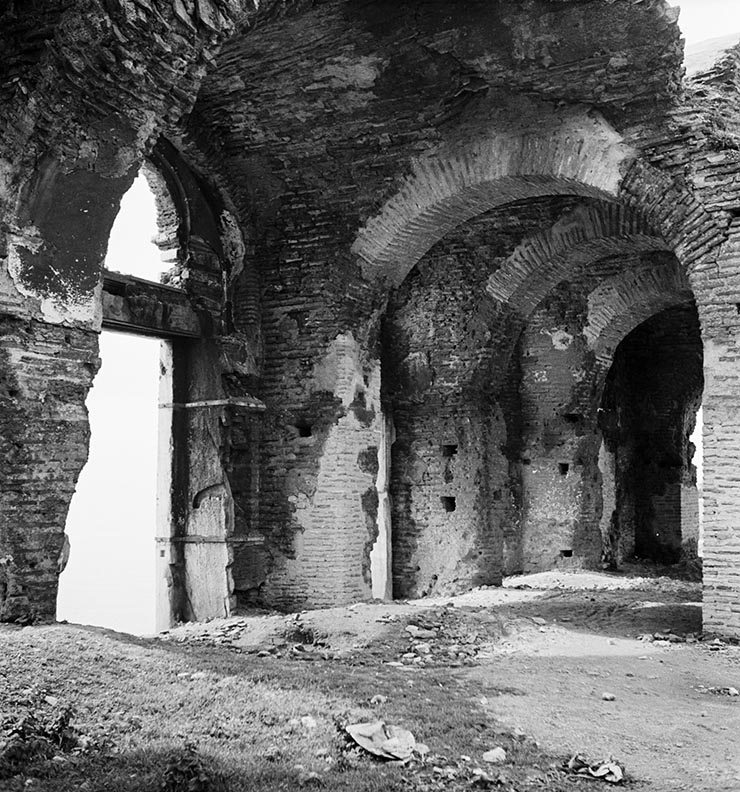
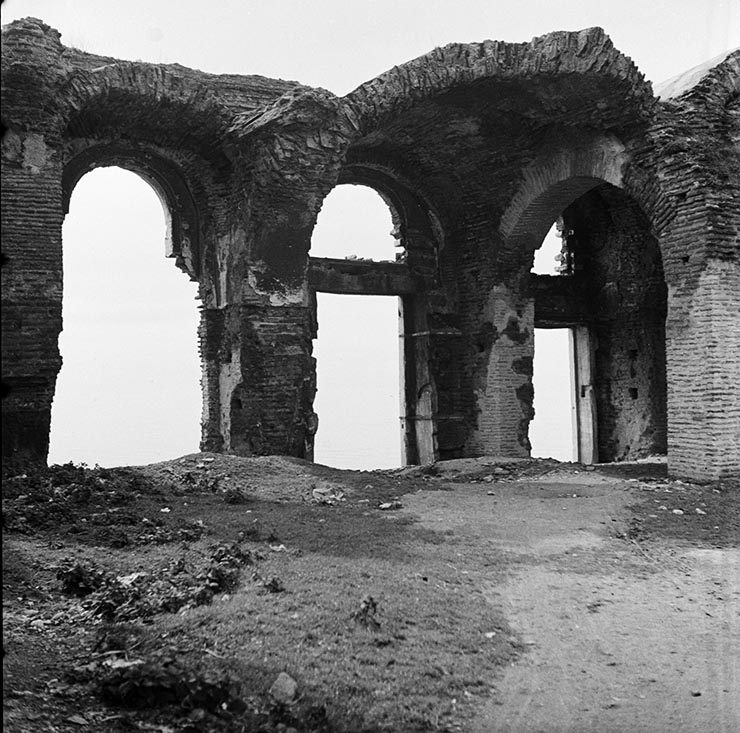 The two pictures above are from the archives of Dumbarton Oaks. It was taken in 1937 and shows the vaulted rooms behind the loggia on the second floor. I was here in 1972. It looks like they cleaned out tall weeds and stuff before taking the picture.
The two pictures above are from the archives of Dumbarton Oaks. It was taken in 1937 and shows the vaulted rooms behind the loggia on the second floor. I was here in 1972. It looks like they cleaned out tall weeds and stuff before taking the picture.
During the reign of Justin I his nephew, the future emperor Justinian lived in the Hormisdas palace which lay between the sea wall and the church of Saints Sergius and Bacchus before he assumed the throne. His wife was the famous former actress, Theodora. The palace connected on two levels with that church. One can still see the filled in door and arches in the wall of the church. This palace has vanished. It was thought that the Buokoleon palace could have been expanded from parts of the Hormisdas Palace. Others speculated that it dated from the 4th century and was built by Theodosius II. The latest dating says the Boukoleon Palace was started by Justinian II in the late 7th century and was vastly enlarged two hundred years later by the emperor Theophilus (reigned 813-842) and Constantine Porphrogennitius (reigned 913-959). The emperor Theophilus also did a lot of work to the sea wall here at the same time.
The palace gets its name from a famous statue of a lion wrestling with a bull that stood on top a set of columns right next to the seashore. This statue was much remarked upon by visitors to Constantinople. There was also a great marble staircase they led up to the first floor of the palace. This was one of the main entrances to the precinct of the Great Palace. It was chosen to receive Imperial visitors because it was so imposing and grand. The reconstructions of the palace below convey what it must have looked like during it's apogee. It really would have been decorated this way - with great flags, banners and tapestries - s it was the first and foremost way foreigners encountered the Imperial court, its ceremonies and splendor. The only thing missing here are the voices of choirs and the acclamations of crowds chanting metric praises of the emperor. assembled here
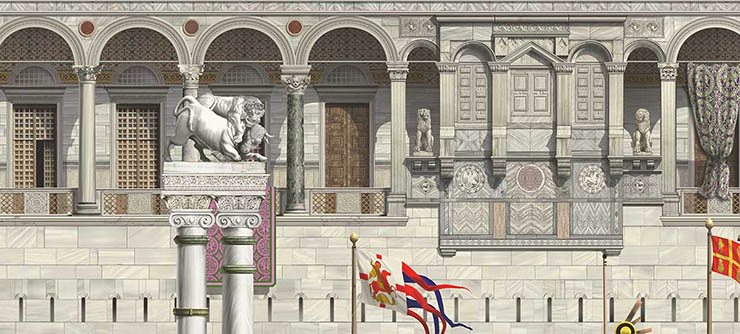
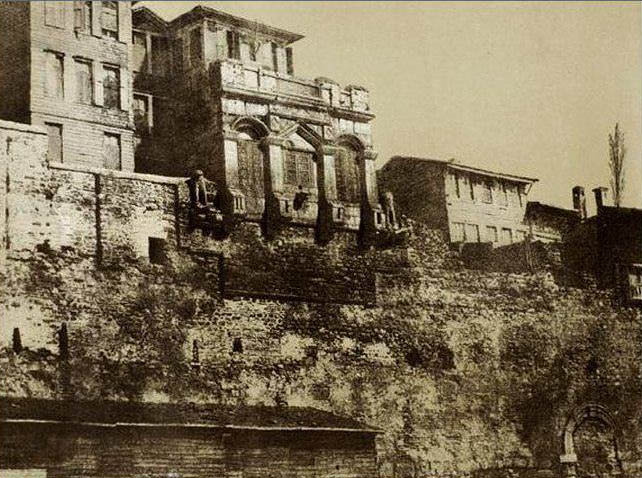 Above is a picture from 1860 showing part of the marble facade of the palace with two lions (the Ottomans called them bears). This entire part of the facade vanished soon after this photograph was taken. As far as I know this is the only visual record of this detail we have. You can see it incorporated into the restorations of the palace on this page.
Above is a picture from 1860 showing part of the marble facade of the palace with two lions (the Ottomans called them bears). This entire part of the facade vanished soon after this photograph was taken. As far as I know this is the only visual record of this detail we have. You can see it incorporated into the restorations of the palace on this page.
The Boukolean was a favorite Imperial residence for the iconoclastic Emperor Theophilos who did a lot of decorating here to modernize and make the palace even more opulent and luxurious.
The military-monkish Emperor Nikephoros II Phocas, concerned about his security enclosed a part of the Great Palace with a towered wall. Within these walls were the a number of shrines including the great Imperial chapel of Saint Stephen - a jewel box of gilded silver, gems, semi-precious stones enclosing the most fabled relics of the city, including the Mandylion and Sidona of Christ. The imperial crowns and other regalia was stored within the walls - and the famous Church of St. Mary or the Pharos - named for a nearby lighthouse tower was here. Nikephoros's wall was deeply recently by the citizens of Constantinople as it cut them off from these important churches and the hillside gardens that had been open to the public previously. Nikephoros made the Boukoleon his principal residence.
- An Ambassador from the Holy Roman Emperor, Liutprand, described Nikephoros as follows:
- ..a monstrosity of a man, a pygmy, fat-headed and like a mole as to the smallness of his eyes; disgusting with his short, broad, thick, and half hoary beard; disgraced by a neck an inch long; very bristly through the length and thickness of his hair; in color an Ethiopian; one whom it would not be pleasant to meet in the middle of the night; with extensive belly, lean of loin, very long of hip considering his short stature, small of shank, proportionate as to his heels and feet; clad in a garment costly but too old, and foul-smelling and faded through age; shod with Sicyonian shoes; bold of tongue, a fox by nature, in perjury, and lying a Ulysses."
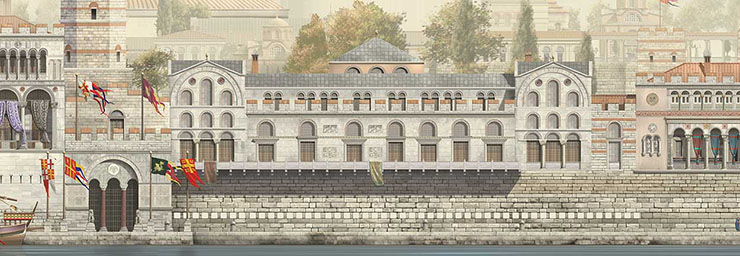
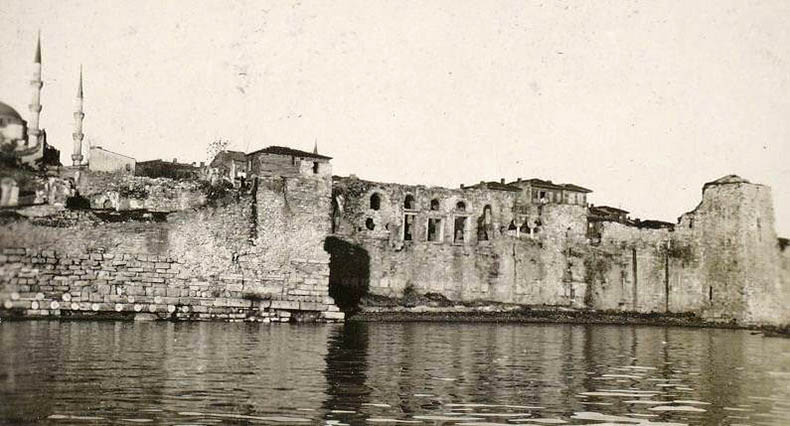 Above is an image from the 19th century showing the palace from the sea.
Above is an image from the 19th century showing the palace from the sea.
.JPG) On the right is a fragment of a white marble angel found in the area of the Boukoleon. The hollowed out areas would have held pieces of colored marbles or inlaid colored waxes.
On the right is a fragment of a white marble angel found in the area of the Boukoleon. The hollowed out areas would have held pieces of colored marbles or inlaid colored waxes.
Nikephoros was assassinated in the Boukoleon. The plot to assassinate Nikephoros began when he dismissed Michael Bourtzes from his position following his disobedience in the siege of Antioch. Bourtzes was disgraced, and he would soon find an ally with whom to plot against Nikephoros. Towards the end of 965, Nikephoros had John Tzimiskes exiled to eastern Asia Minor for suspected disloyalty. Both a popular and a powerful public figure, the exile of Tzimiskes ensured Nikephoros' demise, and he was assassinated in his apartment by Tzimiskes himself on December 11 969. The conspirators had climbed up robes that had been from lowered the seashore from the loggia-balcony of the palace. Nikephoros thought he was safe within his walls with his Imperial Guard, but he wasn't. His wife let them into the Imperial bedchamber. He pleaded for his life but his head was cut off - what a mess. Following his death, the Phokas family broke into insurrection under Nikephoros' nephew Bardas Phokas, but their revolt was promptly subdued as Tzimiskes ascended the throne.
After this murder a large, permanent guard was placed along the facade of the palace to protect it from intruders from the sea. This guard was very effective and was in place for 200 years.
The Emperor Alexis Comnenus lived here. From the Alexiad, written by his daughter Anna we read:
"And he himself with his brothers and mother and nearest male relations moved into the 'Upper' palace, which is also called 'Boucoleon' for the following reason. Not far from its walls a harbour had been constructed long ago of native stone and marbles, and there stood a sculptured lion seizing a bull-for he is clinging to the bull's horn, pulling his head back, and has fixed his teeth in the bull's throat. So from this statue the whole place, that is both the buildings there and the harbour itself, has been named Boucoleon."
In the 12th century Emperor Manuel Comnenus, Alexis's son, used the palace for state occasions and as a guest palace for visiting royalty, important ambassadors and military leaders of the Crusades. In 1161 the sultan of Rum, Kilij Arslan II stayed here, and 1171 with the King of Jerusalem, Amalric stayed here. The palace also served as a religious meeting place, when Emperor Manuel held an important church council here in 1166. I believe the Deesis mosaic in Hagia Sophia was made in conjunction with this council. Since Hagia Sophia was a Patriarchal church Manuel could not have ordered and installed the mosaic there, only the Patriarch could do it. Manuel could have paid for it as a donation to the church. As far as the council is concerned, Manuel wanted to house and host the council so he could exercise more control over the decisions it made and impress the participants.
In the late 12th century the infamous rebel Andronikos Comnenus, was imprisoned near the Boukoleon Palace, but managed to escape. He had a copy of the key to his cell made by one of his servants who was allowed to bring him food. A mold of the key was made in wax and smuggled out in a wine amphora. The duplicate key came back the same way. After forcing his way through tall grass, weeds and overgrowth in this area of the palace grounds, he was captured by the guards who found him trying to slither down a rope in order to board a boat with an accomplice. They tried to lie their way out of the situation by claiming to be illiterate foreigners who didn't understand Greek, slaves that were fleeing a cruel master, who would killed them if they were returned to him. Combined with bribes they were released and Andronikos escaped.
During the Fourth Crusade the palace of Boukoleon was seized by Boniface of Montferrat who wrote:
"rode all along the shore to the palace of Bucoleon, and when he arrived there it surrendered, on condition that the lives of all therein should be spared. At Bucoleon were found the larger number of the great ladies who had fled to the castle, for there were found the sister of the King of France, who had been empress, and the sister of the King of Hungary, who had also been empress, and other ladies very many. Of the treasure that was found in that palace I cannot well speak, for there was so much that it was beyond end or counting."
After the recapture of the city by the Byzantines in 1270 the palace was renovated and used by the Paleologian rulers of the city. It fell into disuse and was in an abandoned state in 1453 when Mehmet II took the city. Below is a picture showing how the palace looked at the turn of the 20th century and how it might have looked in 1203.
Bob Atchison
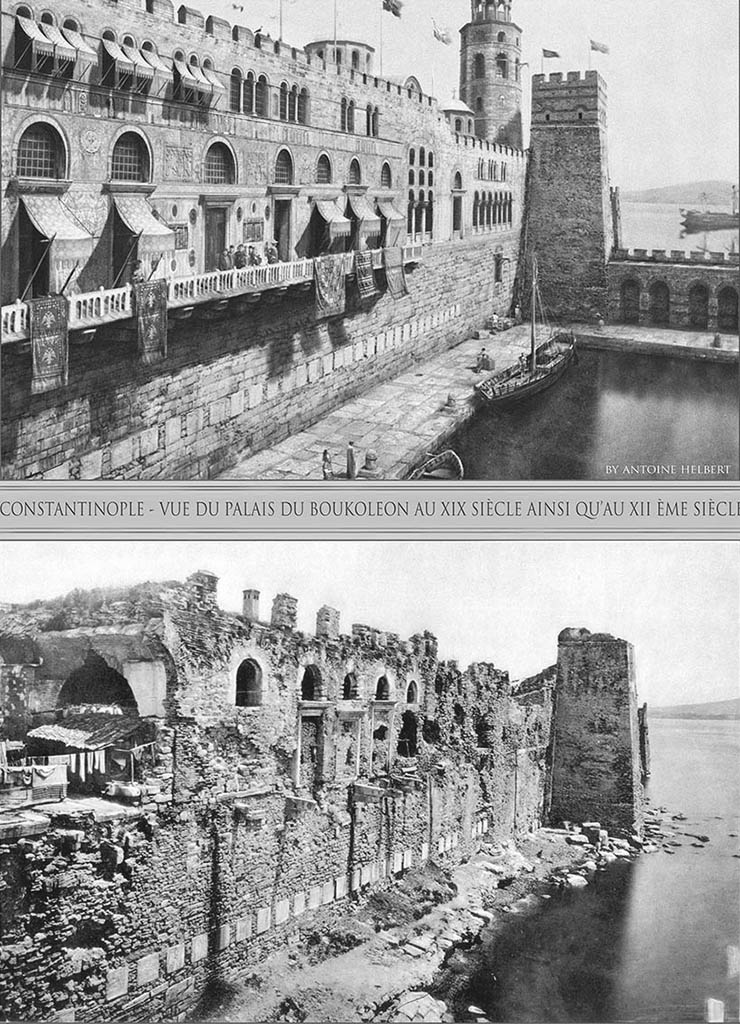
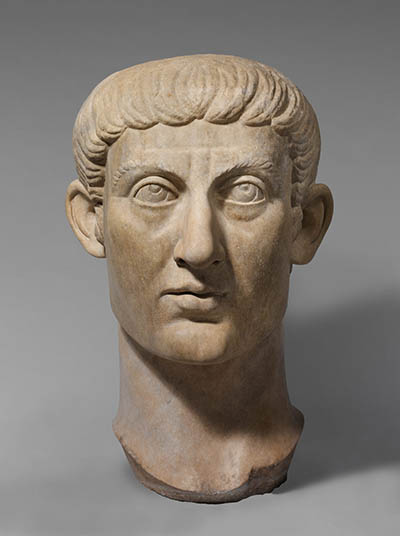 This over-life-sized marble head of Constantine is 37 inches tall and weighs more than 1100 lbs. It was mass-produced in a good quality marble. It was part of a government order for heads to be later inserted into other statues. Since the head was meant to be placed in another statue, with drapery over the head, it was not necessary to finish the hair.
This over-life-sized marble head of Constantine is 37 inches tall and weighs more than 1100 lbs. It was mass-produced in a good quality marble. It was part of a government order for heads to be later inserted into other statues. Since the head was meant to be placed in another statue, with drapery over the head, it was not necessary to finish the hair.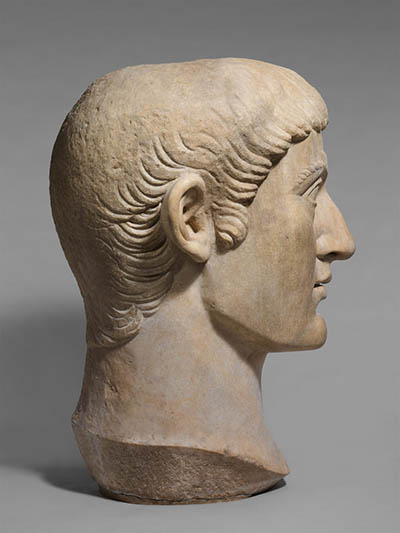 Wow, what a profile! The portrait head resembles Augustus. The mouth and chin are finely modeled and the resemblance to Augustus was intentional.
Wow, what a profile! The portrait head resembles Augustus. The mouth and chin are finely modeled and the resemblance to Augustus was intentional.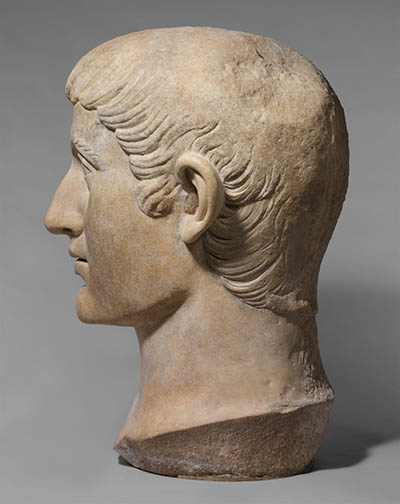 This bust has survived in an amazing condition. The nose is perfect.
This bust has survived in an amazing condition. The nose is perfect.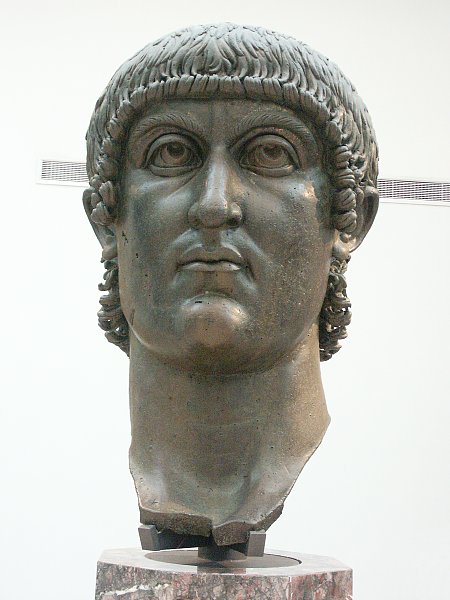 This colossal bronze statue of Constantine is in the Capitoline Museum in Rome. A finger from this statue has recently been connected to the hand. The hand is below. The finger has been previously believed to be a toe from another, unknown, colossal bronze.
This colossal bronze statue of Constantine is in the Capitoline Museum in Rome. A finger from this statue has recently been connected to the hand. The hand is below. The finger has been previously believed to be a toe from another, unknown, colossal bronze.
.jpg)

 Over the last 30 years one of the saddest areas in Istanbul was the neglected ruins of an Imperial palace that was built into the seawall. I first saw it in 1972, on my first trip to Constantinople-Istanbul. I will never forget my ride into the city from the airport and my first sight of the great Land Walls and Hagia Sophia. I was here after so many years of dreaming of it. As I was on my way I looked for all the landmarks I had studied since I was a kid. I knew the places where the vanished churches had been, like the
Over the last 30 years one of the saddest areas in Istanbul was the neglected ruins of an Imperial palace that was built into the seawall. I first saw it in 1972, on my first trip to Constantinople-Istanbul. I will never forget my ride into the city from the airport and my first sight of the great Land Walls and Hagia Sophia. I was here after so many years of dreaming of it. As I was on my way I looked for all the landmarks I had studied since I was a kid. I knew the places where the vanished churches had been, like the 



 The two pictures above are from the archives of Dumbarton Oaks. It was taken in 1937 and shows the vaulted rooms behind the loggia on the second floor. I was here in 1972. It looks like they cleaned out tall weeds and stuff before taking the picture.
The two pictures above are from the archives of Dumbarton Oaks. It was taken in 1937 and shows the vaulted rooms behind the loggia on the second floor. I was here in 1972. It looks like they cleaned out tall weeds and stuff before taking the picture.






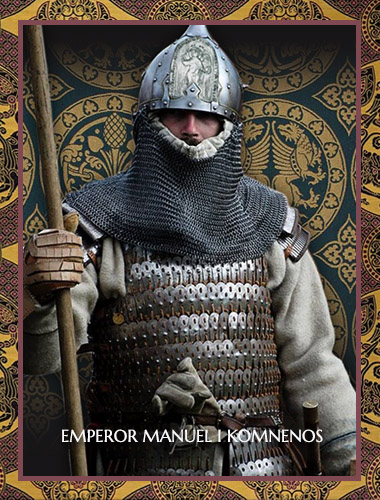

 click here for icons of christ
click here for icons of christ click here for icons of the theotokos
click here for icons of the theotokos click here for icons of angels
click here for icons of angels click here for icons of saints
click here for icons of saints








